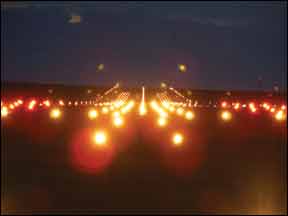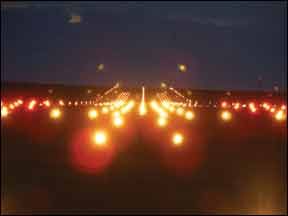You just broke out of the clag on final, late in the day, with the weather at minimums, when illusion strikes. Are you low on the approach? High? Not sure? At the last moment you realize you’re high and long; time to go missed. Maybe it worked the other way around; you’re on approach and as you get to where you expect the threshold marks to pass below you realize you’re low, short and about to touch down—short of the runway.

288
At its worst, these vision deceptions can contribute to spatial disorientation in VMC that’s more confusing than the dizziness of becoming disoriented inside the eggshell of IMC. Either way, you’ve likely experienced this and maybe still don’t understand why. It is, after all, decent VMC under the overcast, so what just happened? You just fell victim to one of the many subtle tricks our eyes can pull on the unwary. With winter’s shorter days and lower sun angles, you may easily find yourself facing the added complication of these illusions at in the first hour after dawn, during dusk and after dark.
Eyes-to-Brain Disconnect
Our ability to spatially orient ourselves, to maintain balance at rest and in motion, involves a complex set of perceptions and interactions between sensors in our inner ears, our brains and our vision. When visual cues mismatch brain input from the inner ear, we can experience dizziness or a sense that our body is moving in conflict with what it sees.
A sense that we’re still turning the opposite direction when we merely changed the rate of an established turn is classic; the feeling of a climb reversing into a descent can come from merely slowing the climb rate—when eyes and inner ears send conflicting data to our brains.
While a known source of aviation accidents from the classic “attempted VFR flight in IMC conditions,” the tricks of clear days and nights can produce their own problems for the unwary.
When on the ground, accurate spatial orientation depends on effectively perceiving, integrating and interpreting visual input, the inner ear (vestibular system) and what are called “proprioceptive” sensors, which are distributed among the skin, muscles, tendons and skeletal joints. Both the vestibular and proprioceptive system receptors detect changes in linear acceleration, angular acceleration and gravity, which are fed to the brain for comparison with visual information.
Whenever these systems disagree, we may suffer a measure of spatial disorientation. The three-dimensional environment of flight can exacerbate those disagreements—even in daylight and good weather—when conditions trick our brain’s final reference check: our eyes.
The references employed by our Mk. I, Mod. 1 Eyeball systems are at once multiple and mundane: Visual references feed our perceptions of distance, speed and depth of observed objects. Sometimes our eyes tell us things that are not true when some of these references are exaggerated or interfered with:
• The relative size of known objects at different distances;
• The form or shape of known objects at different distances;
• The relative velocities of different images passing before us and their distance—which makes nearer objects appear to move faster than more-distant items;
• Placement of known objects so something located in front of another one appears to be closer to our vantage point;
• Variations of texture and/or contrast of known objects at different distances—the farther away an object the less detail we see;
• Differences in illumination perspective of objects due to light and shadows; and
• Differences in aerial perspective of visualized objects—objects farther way take on a blurry, softer nature.
Now…throw into the mix the wide variation of runway lengths, widths, slopes and variations in adjacent terrain, along with the sometimes-abrupt transition from instrument to visual flight, and there’s great potential for disorientation.
Illusions Aloft
Knowing the details of the airport where you plan to land can help a pilot mitigate the risks of these illusions. We can learn about slopes, surrounding terrain and obstacle issues by studying charts or with a call to the airport in question: You can learn whether the airport’s peculiarities have tricked others and gain some insights into the approach and the surrounding area that can contribute to the dirty tricks of visual illusions.
Let’s look at some of the tricks our brains are subject to on even clear days, when such an illusion or dispute between eyes and brain when presented with a sloping runway can prompt us to negatively alter our descent.
Runway Slope
While few runways are perfectly flat from end-to-end, we condition ourselves to see them that way unless there are obvious visual cues. A runway sloping uphill on otherwise flat terrain can create the same view as approaching a flat version of that runway from too high an altitude—because we see more pavement than we expect.
That illusion, if believed, may prompt the pilot to pitch down to lose the (perceived) excess altitude; if too close to the threshold, premature arrival is in store; alternately, the added airspeed may be the last thing a pilot wants on a short runway.
Reverse the situation to put a downhill runway on that otherwise flat ground and the different illusion produces its own challenges, creating a false perception the plane is too low on final.
Pitching up to slow a descent or, worse, transitioning into a climb could put the pilot into a stall very close to the ground. One result often is a short landing. Even absent a stall, the pitch-up slows your forward progress and can exacerbate your controlled descent into a behind-the-power-curve sink.
Not pretty, and not good for the airplane. The pilot who senses a problem and goes around exercised the smart response to both such situations.
Flattops Amid Slopes
Let’s change the scenario further: final approach to a level runway on uphill terrain. Fall for this illusion and you’re likely to pitch the aircraft nose-down to lose altitude and, again, you’ve maneuvered yourself into a lower approach and the prospect of landing short or, conversely, flaring short of the runway and risking a low-altitude stall. Pitching the aircraft nose-down will result in a low, dragged-in approach absent a swift adjustment in engine power. Absent added power, you will land short of your target, or short of the runway.
Flipping this scenario into an approach over downhill terrain to a level runway can make us believe we’re too low, resulting in an increase in pitch, power or both. Now you’re less likely to stall short, but are more likely to eat up a lot of runway before you touch down.
Combine this problem with a short runway and an overrun can easily occur.
When in doubt, go around.
Size Matters
Very long runways and very narrow runways both contribute to the same illusion of being too high on final; pitch down and you’re back to the same issue as seeming too high because of the runway-slope issue. Coming up short is the likely outcome; come up short of the runway end and your gear will curse you forever.
Conversely, very wide runways can contribute to an illusion of insufficient altitude; now you’re back in the position of pitching up—low and slow—and once again risking a low-altitude stall. Again, the better choice is a go-around.
Black Holes
While astronomers and theoretical physicists search the heavens for black holes, pilots can point to any number of them—the black holes of water or unlighted terrain immediately before or after a runway at night. The Mobile (Ala.) Downtown Airport (BFM) has one: Runway 14 ends not far from the water’s edge of Mobile Bay. Approaching at night, the runway lights seem to just end in that black hole—with a lighted marine-navigation buoy offshore adding confusion to the sight picture. Of course, black holes exist at many other airports—anywhere the runway starts or ends adjacent to unlighted, featureless terrain or water.
Remove the cues for our peripheral vision and eliminate the horizon while approaching BFM’s Runway 14 and the problems possible can be particularly insidious by setting up an illusion of being upright while the runway is tilted to the left and uphill.
Another especially insidious black-hole illusion may occur when on approach with no lights before the runway and with city lights or rising terrain beyond the runway—like Runway 32 at BFM. Such a set of conditions can produce an illusion of being high on final. Succumb to this one and you may instinctively lower your approach slope and risk coming up short—caught by a black hole.
Sundry Other Illusions
Scientists call this one an auto-kinetic illusion—the (false) impression of a stationary object moving in front of the flight path; staring at that fixed single point of light—it can be on the ground or in the sky—on a pitch-black night with a featureless background can make you perceive the light is converging on you…on a collision course.
Here’s another night-time trickster: the false visual reference illusions, which can cause you to orient the plane in reference to a false or slanted horizon. Flying over an angled cloud layer in the daylight or featureless terrain at night with no apparent difference between the stars and the ground lights contribute to this illusion, as does night flight above a featureless terrain with a clearly defined pattern of ground lights and no visible sky overhead.
Mitigation Strategy: Practice
Experiencing sensory illusions first-hand is the best preparation for encountering them in-flight and a safe way to learn the appropriate responses. As is often the case, practicing to recognize and compensate for these illusions in actual conditions provides us with the best preparation—or hedge—against falling for any of these traps. The FAA offers some suggestions for ameliorating illusory issues like spatial orientation and visual illusions: practice, practice, practice.
One excellent opportunity appears regularly at all the major air shows and many fly-in events: the opportunity to personally experience sensory illusions in a Barany chair, a Vertigon, a GYRO, or a Virtual Reality Spatial Disorientation Demonstrator (VRSDD). The Aerospace Medical Education Division of the FAA Civil Aerospace Medical Institute also offers spatial disorientation demonstrations in Oklahoma City.
Another hedge: regular training to maintain your skills at flying solely by reference to instruments. A good time to exercise those skills is when flying at night or in reduced visibility.
Learning the individual geographical conditions where you plan to fly is another useful step. Remember, though, no attempting visual flight if the possibility exists of deteriorating weather trapping you and spurring another article about the dangers of continued VFR flight into IMC. For those times when you experience a visual illusion in-flight—and most of us have at some point—trust your instruments more than your own senses. Remember: succumbing to the lying liar that is our inner ear is the primary cause of accidents when pilots fail to trust their instruments—or don’t have the training to use them well.
Practice often. Knowing the traps and perils of illusions, day and night, will help keep you from becoming a statistic.




